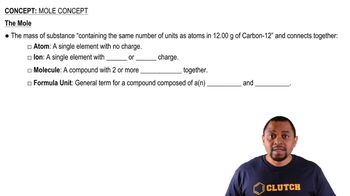Determine the empirical formulas of the compounds with the following compositions by mass: (a) 74.0% C, 8.7% H, and 17.3% N
Ch.3 - Chemical Reactions and Reaction Stoichiometry
Chapter 3, Problem 48c
Determine the empirical formulas of the compounds with the following compositions by mass: (c) 60.0% C, 4.4% H, and the remainder O
 Verified step by step guidance
Verified step by step guidance1
Identify the mass percentages of each element: 60.0% C, 4.4% H, and the remainder O. Calculate the percentage of O by subtracting the sum of the percentages of C and H from 100%.
Assume a 100 g sample of the compound, which means you have 60.0 g of C, 4.4 g of H, and the remainder in grams of O.
Convert the masses of each element to moles by dividing by their respective atomic masses: C (12.01 g/mol), H (1.008 g/mol), and O (16.00 g/mol).
Determine the mole ratio of the elements by dividing each element's mole value by the smallest number of moles calculated in the previous step.
If necessary, multiply the mole ratios by a whole number to obtain the smallest whole number ratio for the empirical formula.

Verified video answer for a similar problem:
This video solution was recommended by our tutors as helpful for the problem above.
Video duration:
1mWas this helpful?
Key Concepts
Here are the essential concepts you must grasp in order to answer the question correctly.
Empirical Formula
The empirical formula of a compound represents the simplest whole-number ratio of the elements present in that compound. It is derived from the mass percentages of each element, which are converted to moles and then simplified to the smallest integer ratio. This formula provides essential information about the composition of the compound without indicating the actual number of atoms in a molecule.
Recommended video:
Guided course

Empirical vs Molecular Formula
Mole Concept
The mole concept is a fundamental principle in chemistry that relates the mass of a substance to the number of particles it contains. One mole of any substance contains Avogadro's number (approximately 6.022 x 10²³) of entities, whether they are atoms, molecules, or ions. This concept is crucial for converting mass percentages into moles, which is necessary for determining the empirical formula.
Recommended video:
Guided course

Mole Concept
Mass Percent Composition
Mass percent composition refers to the percentage by mass of each element in a compound. It is calculated by dividing the mass of each element in a sample by the total mass of the sample and multiplying by 100. Understanding mass percent composition is essential for converting the given percentages into moles, which is the first step in finding the empirical formula of a compound.
Recommended video:
Guided course

Mass Percent Calculation
Related Practice
Textbook Question
Textbook Question
Determine the empirical formulas of the compounds with the following compositions by mass: (b) 57.5% Na, 40.0% O, and 2.5% H (c) 41.1% N, 11.8% H, and the remainder S
Textbook Question
Determine the empirical formulas of the compounds with the following compositions by mass: (a) 42.1% Na, 18.9% P, and 39.0% O (b) 18.7% Li, 16.3% C, and 65.0% O
1
views
Textbook Question
A compound whose empirical formula is XF3 consists of 65% F by mass. What is the atomic mass of X?
Textbook Question
The compound XCl4 contains 75.0% Cl by mass. What is the element X?
Textbook Question
What is the molecular formula of each of the following compounds? (a) empirical formula CH, molar mass 5 78.0 g/mol (b) empirical formula NH2Cl, molar mass = 51.5 g/mol
1
views
